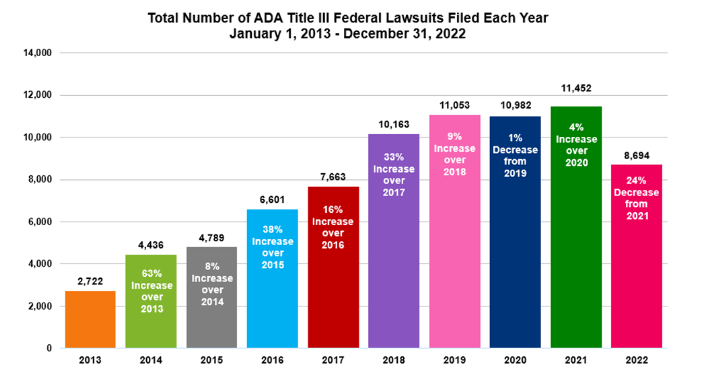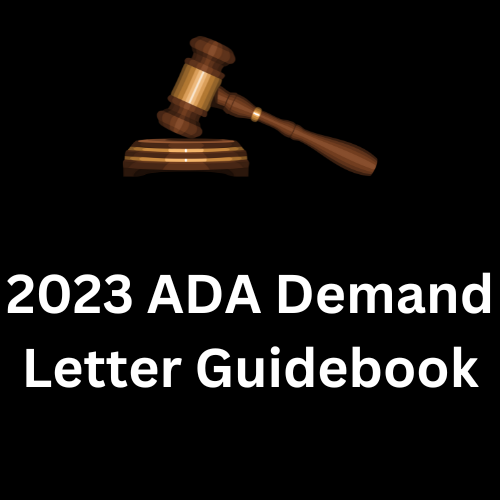Introduction
What should you do when you receive a demand letter claiming your digital properties do not comply with the ADA?
When it comes to website accessibility, there are thousands of demand letters sent to businesses every week. There are even online courses “Website ADA Compliance: Website Demand Letters & Lawsuits.” This helps law firms understand demand letters, defend them and issue them.
A legal firm or representative will send an ADA demand letter accusing your organization of failing to comply with ADA. The letter will allege that your organization discriminates against individuals with disabilities. And neglects to provide them with equal access opportunities.
This implies that your website or app does not cater to individuals who are visually impaired or have other disabilities. This includes those who rely on assistive technologies such as screen readers. This deficiency commonly arises from your website or app not meeting the required technical standards.
Don’t’ ignore them!
Failure to respond to demand letters could potentially be interpreted as an admission of guilt through silence. Our primary suggestion is to promptly contact your lawyer for assistance. They can assist you in assessing the demand letter, formulating an appropriate response, and devising a plan for future actions.
What is an ADA Demand letter?
An ADA demand letter alleges that an organization’s digital property does not comply with the American Disabilities Act (ADA). Digital properties include public-facing websites, web pages, mobile app, etc. It is sent to businesses who do not ensure equal access according to the Web Content Accessibility Guidelines (WCAG) 2.1.
The Americans with Disabilities Act (ADA)
Title III of the Americans with Disabilities Act (ADA) prohibits discrimination against individuals with disabilities in places of public accommodation.
The ADA also requires businesses to make online content accessible to those requiring assistive devices to navigate a website.
Who is enforcing the ADA?
The Department of Justice (DOJ)
In the past, the DOJ was responsible for enforcing the Americans with Disabilities Act (ADA). However, the current administration has taken a more limited role in intervening on the same level.
State and Local Agencies
The Attorneys General in certain states, notably New York and Massachusetts, enforce digital accessibility regulations through state mechanisms.
Private Legal Counsel
Attorneys who specialize in ADA-related cases are actively pursuing claims related to web accessibility. Some law firms are particularly prolific in this area.
Advocacy Groups
The National Association for the Deaf and the American Council for the Blind have been actively advocating for accessibility online.
Rise in ADA Title III Litigation
ADA Title III case filings in federal court had been on a sharp upward trajectory. That year, there were only 2,722 lawsuits nationwide. Eight years later, in 2021, there were 11,452 such lawsuits. In-between, year over year increases ranged from 4% to 63%. 2020 was the only “down” year, with a 1% slight decrease which was likely attributable to pandemic restrictions.

Figure 1. Total number of ADA Title III Federal lawsuits filed each year January 1, 2013 to December 31, 2022
Source: ADA Title III
Uncertainty about ADA Requirements
While litigation continues to increase, there are still no specific requirements that define how ADA is applied to the Internet. Over 85% of survey respondents said they wanted the ADA updated to include specific regulations for digital accessibility.
Numerous organizations encounter challenges in achieving digital accessibility compliance due to the lack of specific language related to web accessibility. The escalation of ADA lawsuits pertaining to web accessibility in U.S. federal courts is staggering. It is steadily increasing from 814 cases in 2017 to nearly 2,900 cases in 2021. These figures represent only a fraction of the legal activity in this field. Furthermore, an estimated 265,000 demand letters related to web accessibility were sent in 2020.
Both state and federal courts have overwhelmingly ruled that digital accessibility is a requirement under Title III of the ADA. The Department of Justice (DOJ) has also established best practices for ADA compliance through its enforcement actions.
However, the uncertainty has led to a rush of law firms looking to make a quick profit. A handful of firms file fly-by night cases against small and medium-sized businesses alleging violation of ADA.
Following this, the Kansas Senate recently passed Senate Bill 258. It aims to deter out-of-state attorneys from filing lawsuits unfairly targeting businesses in Kansas. The bill was sent to Kansas Governor Laura Kelly who signed it into law in April.
The Only Digital Accessibility Case to go to Trial
Nearly all digital accessibility litigation is resolved at the settlement table. One case went to trial and received a ruling in June 2017.
Gil v. Winn-Dixie Stores, Inc.
The Plaintiff Juan Carlos Gil, a Florida resident who was legally blind, uses a screen reader to access the internet. He sued Winn-Dixie Stores, a grocery store chain in June 2016. Gil alleged his screen reader did not function with the supermarket chain’s website. He filed an ADA complaint in the Southern District of Florida.
The plaintiff visited the website to refill his prescriptions. Subsequently, he found 90% of the tabs were non-functional with his assistive tools.
In June 2017, the lawsuit proceeded to a two-day bench trial. It features testimony from Gil, a web accessibility expert, and a representative from Winn Dixie, the supermarket chain. He argued that the website qualified as a “place of public accommodation under the ADA.” As a result of the court proceedings, Winn-Dixie was subsequently ordered to ensure accessibility on its website.
Five Essential Tips to Create a Compliance Timeline
- Achieving compliance with WCAG 2.0 AA within a span of two years poses significant challenges. Establish a five-year timeline for remediation, striking a balance between cost efficiency, quality, and a reasonable completion timeframe.
- Another viable approach is to prioritize making key functions of a website or app accessible sooner. It allows for a longer timeline to bring the remaining aspects into conformance.
- In comparison, achieving compliance for mobile systems often presents a faster process compared to web systems. Consider prioritizing the compliance of the mobile site or app on an aggressive timeline. Follow-up with remediation of the desktop version.
- Bringing third-party solutions, such as UI libraries, into compliance can be complex. It is advisable to request a carve-out or additional time to thoroughly research and implement new solutions.
- Before agreeing to a compliance timeline, consult with your product owners. This proactive step ensures that your audit and remediation period does not coincide with peak seasons.
What is the Course of Action after receiving an ADA Demand Letter?
Prior to taking any action, it is essential to update your legal advisors. Bring in a team of digital accessibility experts who specialize in WCAG and ADA Title III standards. This team will collaborate closely with both you and your legal team. And ensure the accessibility of your digital properties and minimize future risks. This guide will cover the following typical steps in this process:
- Assessing the legitimacy of the demand letter
- Verifying the technical claims made in the letter
- Strategizing with your legal counsel regarding a potential response
- Conducting a comprehensive audit of your entire digital portfolio
- Communicating your commitment to accessibility publicly
- Implementing a comprehensive digital accessibility policy
Assessing the legitimacy of the ADA demand letter
An ADA demand letter differs from a lawsuit, but it can serve as a precursor to legal action. The letter must be carefully evaluated by your legal advisors. It is important to initially assess the legitimacy of the letter in consultation with your attorney. Here are some key factors to consider during the review process:
Law firm: Is the law firm representing the plaintiff known for pursuing valid lawsuits based on genuine errors,? Or does it have a reputation for filing numerous lawsuits with the intention of securing fast settlements?
Standing: Does the plaintiff have the legal right to file a lawsuit? Can they demonstrate personal jurisdiction to sue you? Or provide evidence of being genuinely affected by the claims stated in the letter?
Merits: Are the allegations made against you clear, enabling you to understand it’s nature and location on your digital assets? This comprehension will assist you and your legal counsel in determining the most appropriate course of action.
Verifying the technical claims made in a ADA Demand letter
Once you confirm legitimacy of the letter’s sender, you must comprehend the extent, technical accuracy, and seriousness of the problems.
- Do the claims made apply to the specific digital property mentioned, and are they technically accurate?
- Are the issues mentioned still existing, or have they already been resolved or replaced?
- If the claims are accurate and present, do they hinder access to the content and functionality of your digital platform?
- Are the issues within your organization’s capacity to fix? Or are they controlled by a third party, such as your content management system?
- Are the issues highlighted based on false positives?
At this stage, thorough documentation is crucial. Engage a partner to generate a formal report to verify the validity of the claims made in the demand letter.
Strategizing with your legal counsel regarding a potential response to a ADA demand letter
Deciding how to respond to a legal demand letter can be a complex matter. If you choose to respond, consider these important factors.
- Is there a strategic advantage in timing your response?
- Do you possess evidence to counter the claims made?
- Can you address and resolve any identified issues prior to responding?
- How significantly does the named issues impact the user experience?
codemantra can provide valuable insights into the current trends and offer the necessary context to support your decision-making process.
Conducting a comprehensive audit of your entire digital portfolio
A comprehensive audit should go beyond simply listing identified issues. It should also provide detailed instructions on how to resolve those issues and rank them based on their severity.
This ranking will assist you in prioritizing your remediation efforts. As you address these issues, it is advisable to review and update your accessibility roadmap. This helps to track your progress over time and mitigate potential future legal risks.
An audit involves a professional assessment of how effectively your digital experience caters to the needs of people with disabilities.
Communicating your commitment to accessibility publicly
It is advisable to take the opportunity to publicly demonstrate your dedication to accessibility. One effective way to achieve this is by publishing an accessibility statement on your website or other digital platforms.
By doing so, you not only emphasize your commitment to accessibility. But also provide visitors with a means to communicate any barriers they may encounter. This eliminates the need for them to resort to sending a demand letter. This proactive approach demonstrates support and creates a welcoming environment for clients or customers with disabilities.
About codemantra
Achieve compliance for your digital information as per global accessibility standards with codemantra’s accessibilityInsight™.
About accessibilityInsight™
accessibilityInsight™ is a cloud-based platform that provides the most efficient solution for document accessibility compliance. To achieve accessibility compliance, accessibilityInsightTM validates documents, fixes, and remediates accessibility errors in PDF documents. AIN offers document remediation with machine learning suggestions along with human oversight.
Highlights
- Hassle free organization of documents.
- Quick and easy validation and remediation support to achieve compliance.
- Supports machine learning alongside human intelligence.
- Comprehensive user experience throughout the process of validation and remediation.

Figure 2. accessibilityInsight My Documents Screen
Why accessibilityInsight?
Validation – Comprehensive manual validation across all document types to comply with PDF U/A standards and WCAG guidelines.
Human assisted intervention – Users can provide alt text for equation and review auto-generated Math descriptions.
Turnaround time – Reduces time taken to make PDFs accessible.
Seamless integration – Easily integrates into any business application or platform workflow.
How codemantra can help?
Get all your digital information compliant quickly and effectively. Ensure accuracy with scalable AI-driven modules and eliminate disproportionate burden.

Figure 3. codemantra’s Scalable Solution
Get in touch: engage@codemantra.com









